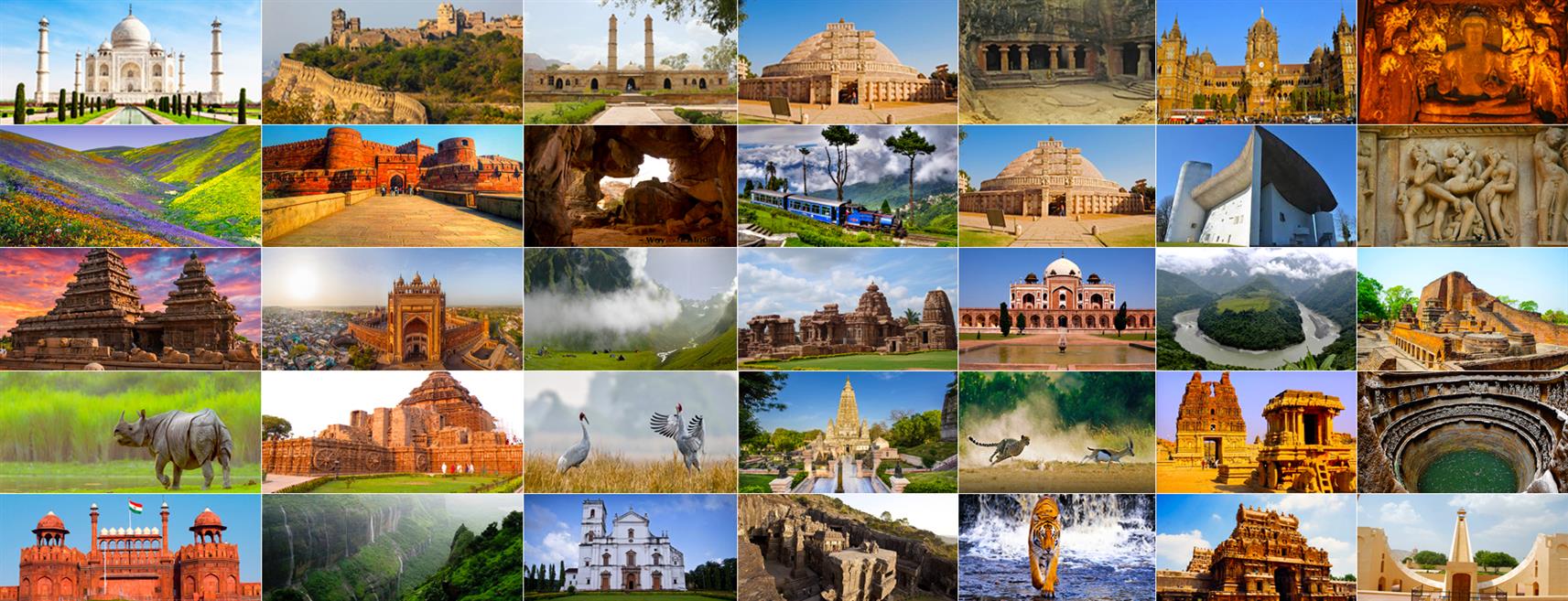Taj Mahal, Agra:
A masterpiece of Mughal architecture, the Taj Mahal is a symbol of eternal love and one of the most iconic landmarks in the world.
Qutub Minar and its Monuments, Delhi:
The tallest brick minaret in the world, Qutub Minar, is surrounded by a complex of ancient monuments dating back to the 12th century.
Red Fort Complex, Delhi:
A symbol of India's rich Mughal heritage, the Red Fort complex is a UNESCO World Heritage Site showcasing grand palaces, gardens, and ornate pavilions.
Fatehpur Sikri, Uttar Pradesh:
Built by Emperor Akbar in the 16th century, Fatehpur Sikri is a well-preserved ancient city known for its architectural splendor and historical significance.
Ellora Caves, Maharashtra:
A UNESCO World Heritage Site, the Ellora Caves feature a stunning collection of rock-cut temples and monasteries representing Hindu, Jain, and Buddhist traditions.
Ajanta Caves, Maharashtra:
Dating back to the 2nd century BCE, the Ajanta Caves are renowned for their exquisite murals and sculptures depicting scenes from Buddhist mythology.
Western Ghats, Maharashtra, Karnataka, Tamil Nadu, Kerala:
A biodiversity hotspot and UNESCO World Heritage Site, the Western Ghats are home to a rich variety of flora and fauna, including endangered species such as the Bengal tiger and Indian elephant.
Sundarbans National Park, West Bengal:
The largest mangrove forest in the world, the Sundarbans National Park is a UNESCO World Heritage Site and a critical habitat for the endangered Royal Bengal tiger.
Great Living Chola Temples, Tamil Nadu:
These 11th and 12th-century temples, including the Brihadeeswarar Temple in Thanjavur, showcase the architectural brilliance of the Chola dynasty and are UNESCO World Heritage Sites.
Elephanta Caves, Maharashtra:
Located on Elephanta Island in Mumbai Harbor, these ancient caves are renowned for their rock-cut sculptures and temples dedicated to Lord Shiva.
Khajuraho Group of Monuments, Madhya Pradesh:
Famous for their intricate carvings depicting erotic themes, the Khajuraho temples are a UNESCO World Heritage Site and a testament to India's architectural and artistic heritage.
Hampi, Karnataka:
The ruins of Hampi, once the capital of the Vijayanagara Empire, are a UNESCO World Heritage Site and a treasure trove of ancient temples, palaces, and monuments.
Chhatrapati Shivaji Terminus, Maharashtra:
Formerly known as Victoria Terminus, this historic railway station in Mumbai is a UNESCO World Heritage Site and an architectural marvel blending Victorian Gothic and Indian elements.
Group of Monuments at Mahabalipuram, Tamil Nadu:
Known for its rock-cut temples and intricately carved sculptures, Mahabalipuram is a UNESCO World Heritage Site and a popular pilgrimage destination.
Humayun's Tomb, Delhi:
A masterpiece of Mughal architecture, Humayun's Tomb is a UNESCO World Heritage Site and a precursor to the Taj Mahal.
Rani ki Vav, Gujarat:
An intricately designed stepwell dating back to the 11th century, Rani ki Vav is a UNESCO World Heritage Site and a stunning example of Indian subterranean architecture.
Mountain Railways of India:
This UNESCO World Heritage Site comprises three historic railway lines in India: the Darjeeling Himalayan Railway, the Nilgiri Mountain Railway, and the Kalka-Shimla Railway.
Champaner-Pavagadh Archaeological Park, Gujarat:
This UNESCO World Heritage Site encompasses an ancient fortified city and sacred hill with archaeological remains dating back to the 8th century.
Rani-ki-Vav, Gujarat:
An intricately designed stepwell dating back to the 11th century, Rani-ki-Vav is a UNESCO World Heritage Site and a stunning example of Indian subterranean architecture.
Chhatrapati Shivaji Maharaj Terminus, Maharashtra:
Formerly known as Victoria Terminus, this historic railway station in Mumbai is a UNESCO World Heritage Site and an architectural marvel blending Victorian Gothic and Indian elements.
India's UNESCO World Heritage Sites are a testament to the country's rich cultural, historical, and natural heritage. From iconic landmarks like the Taj Mahal to lesser-known treasures like the Western Ghats, each site offers a glimpse into India's diverse and fascinating past. Whether you're exploring ancient temples, admiring architectural marvels, or marveling at natural wonders, a visit to these UNESCO World Heritage Sites is sure to leave a lasting impression and deepen your appreciation for India's enduring legacy.





